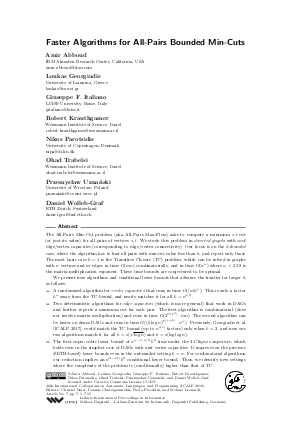@InProceedings{abboud_et_al:LIPIcs.ICALP.2019.7,
author = {Abboud, Amir and Georgiadis, Loukas and Italiano, Giuseppe F. and Krauthgamer, Robert and Parotsidis, Nikos and Trabelsi, Ohad and Uzna\'{n}ski, Przemys{\l}aw and Wolleb-Graf, Daniel},
title = {{Faster Algorithms for All-Pairs Bounded Min-Cuts}},
booktitle = {46th International Colloquium on Automata, Languages, and Programming (ICALP 2019)},
pages = {7:1--7:15},
series = {Leibniz International Proceedings in Informatics (LIPIcs)},
ISBN = {978-3-95977-109-2},
ISSN = {1868-8969},
year = {2019},
volume = {132},
editor = {Baier, Christel and Chatzigiannakis, Ioannis and Flocchini, Paola and Leonardi, Stefano},
publisher = {Schloss Dagstuhl -- Leibniz-Zentrum f{\"u}r Informatik},
address = {Dagstuhl, Germany},
URL = {https://drops.dagstuhl.de/entities/document/10.4230/LIPIcs.ICALP.2019.7},
URN = {urn:nbn:de:0030-drops-105833},
doi = {10.4230/LIPIcs.ICALP.2019.7},
annote = {Keywords: All-pairs min-cut, k-reachability, network coding, Directed graphs, fine-grained complexity}
}

 Creative Commons Attribution 3.0 Unported license
Creative Commons Attribution 3.0 Unported license





